This is an old revision of this page, as edited by 83.100.174.82 (talk) at 15:48, 28 January 2015 (→Culinary: rm peacock term - nothing unusual about oilseed stability in absence of air and light). The present address (URL) is a permanent link to this revision, which may differ significantly from the current revision.
Revision as of 15:48, 28 January 2015 by 83.100.174.82 (talk) (→Culinary: rm peacock term - nothing unusual about oilseed stability in absence of air and light)(diff) ← Previous revision | Latest revision (diff) | Newer revision → (diff) For other uses, see Flax (disambiguation).
| Flax Linum usitatissimum | |
|---|---|

| |
| Flax plant | |
| Scientific classification | |
| Kingdom: | Plantae |
| (unranked): | Angiosperms |
| (unranked): | Eudicots |
| (unranked): | Rosids |
| Order: | Malpighiales |
| Family: | Linaceae |
| Genus: | Linum |
| Species: | L. usitatissimum |
| Binomial name | |
| Linum usitatissimum L. | |
| Synonyms | |
| |
Flax (also known as common flax or linseed), with the binomial name Linum usitatissimum, is a member of the genus Linum in the family Linaceae. It is a food and fiber crop that is grown in cooler regions of the world. In addition to referring to the plant itself, the word "flax" may refer to the unspun fibers of the flax plant. The plant species is known only as a cultivated plant, and appears to have been domesticated just once from the wild species Linum bienne, called pale flax.
Description
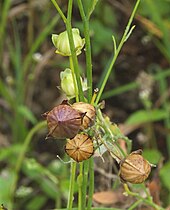
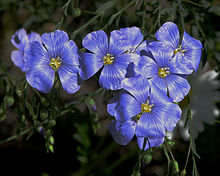
Several other species in the genus Linum are similar in appearance to Linum usitatissimum, cultivated flax, including some that have similar blue flowers, and others with, white, yellow, or red flowers. Some of these are perennial plants, unlike L. usitatissimum, which is an annual plant.
Cultivated flax plants grow to 1.2 m (3 ft 11 in) tall, with slender stems. The leaves are glaucous green, slender lanceolate, 20–40 mm long and 3 mm broad.
The flowers are pure pale blue, 15–25 mm diameter, with five petals. The fruit is a round, dry capsule 5–9 mm diameter, containing several glossy brown seeds shaped like an apple pip, 4–7 mm long.
History
The earliest evidence of humans using wild flax as a textile comes from the present day Republic of Georgia, where spun, dyed, and knotted wild flax fibers were found in Dzudzuana Cave and dated to the Upper Paleolithic, 30,000 years ago. Flax was first domesticated in the Fertile Crescent region. There is evidence of a domesticated oil-seed flax with increased seed size by 9,000 years ago from Tell Ramad in Syria. Use of the crop steadily spread, reaching places as far as Switzerland and Germany by 5,000 years ago (3,000 BCE). In China and India domesticated flax was cultivated by at least 5,000 years ago (3,000 BCE).
Flax was extensively cultivated in ancient Egypt, where temple walls had paintings of flowering flax and mummies were entombed in linen. Egyptian priests only wore linen, as flax was considered a symbol of purity. Phoenicians traded Egyptian linen throughout the Mediterranean, and the Romans used it for their sails. As the Roman Empire declined, so did flax production, but Charlemagne revived the crop in the 8th century CE with laws designed to publicize the hygiene of linen textiles and the health of linseed oil. Eventually, Flanders became the major center of the linen industry in the European Middle Ages. In North America, flax was introduced by the colonists and it flourished there. But by the early 20th century cheap cotton and rising farm wages had caused production of flax to become concentrated in northern Russia, which came to provide 90% of the world's output. Since then flax has lost its importance as a commercial crop, due to the easy availability of more durable fibers.
Uses
Flax is grown for its oil, used as a nutritional supplement, and as an ingredient in many wood-finishing products. Flax is also grown as an ornamental plant in gardens. Flax fibers are used to make linen. The Latin species name usitatissimum means most useful.
Flax fibres are taken from the stem of the plant and are two to three times as strong as those of cotton. As well, flax fibers are naturally smooth and straight. Europe and North America depended on flax for vegetable-based cloth until the nineteenth century, when cotton overtook flax as the most common plant used for making rag-based paper. Flax is grown on the Canadian Prairies for linseed oil, which is used as a drying oil in paints and varnish and in products such as linoleum and printing inks.
Flax seeds
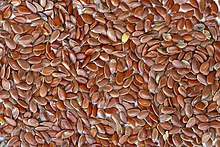
Flax seeds come in two basic varieties: 1. brown; and 2. yellow or golden (also known as golden linseeds). Most types have similar nutritional characteristics and equal numbers of short-chain omega-3 fatty acids. The exception is a type of yellow flax called solin (trade name Linola), which has a completely different oil profile and is very low in omega-3 FAs. Flax seeds produce a vegetable oil known as flaxseed oil or linseed oil, which is one of the oldest commercial oils. It is an edible oil obtained by expeller pressing, sometimes followed by solvent extraction. Solvent-processed flax seed oil has been used for many centuries as a drying oil in painting and varnishing.
Although brown flax can be consumed as readily as yellow, and has been for thousands of years, its better-known uses are in paints, for fiber, and for cattle feed.
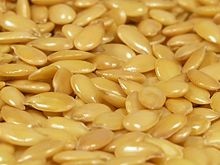
Culinary
One hundred grams of ground flax seed supplies about 450 calories, 41 grams of fat, 28 grams of fiber, and 20 grams of protein.
Flax seed sprouts are edible, with a slightly spicy flavor. Excessive consumption of flax seeds with inadequate water can cause bowel obstruction. In northern India, flaxseed, called (tisi or alsi), is traditionally roasted, powdered, and eaten with boiled rice, a little water, and a little salt.
Whole flax seeds are chemically stable, but ground flaxseed can go rancid at room temperature in as little as one week, although there is contrary evidence. Refrigeration and storage in sealed containers will keep ground flax from becoming rancid for a longer period; under conditions similar to those found in commercial bakeries, trained sensory panelists could not detect differences between bread made with freshly ground flax and bread made with milled flax stored for four months at room temperature. Milled flax is stable to oxidation when stored for nine months at room temperature if packed immediately without exposure to air and light and for 20 months at ambient temperatures under warehouse conditions.
Three natural phenolic glucosides, secoisolariciresinol diglucoside, p-coumaric acid glucoside and ferulic acid glucoside, can be found in commercial breads containing flaxseed.
Medicinal
Linum usitatissimum seeds have been used in the traditional Austrian medicine internally (directly soaked or as tea) and externally (as compresses or oil extracts) for treatment of disorders of the respiratory tract, eyes, infections, cold, flu, fever, rheumatism and gout.
Nutrients and clinical research
Main article: Linseed oil| Nutritional value per 100 g (3.5 oz) | |||||||||||||||||||||||||||||||||||||||||||
|---|---|---|---|---|---|---|---|---|---|---|---|---|---|---|---|---|---|---|---|---|---|---|---|---|---|---|---|---|---|---|---|---|---|---|---|---|---|---|---|---|---|---|---|
| Energy | 2,234 kJ (534 kcal) | ||||||||||||||||||||||||||||||||||||||||||
| Carbohydrates | 28.88 g | ||||||||||||||||||||||||||||||||||||||||||
| Sugars | 1.55 g | ||||||||||||||||||||||||||||||||||||||||||
| Dietary fiber | 27.3 g | ||||||||||||||||||||||||||||||||||||||||||
| Fat | 42.16 g | ||||||||||||||||||||||||||||||||||||||||||
| Saturated | 3.663 g | ||||||||||||||||||||||||||||||||||||||||||
| Monounsaturated | 7.527 g | ||||||||||||||||||||||||||||||||||||||||||
| Polyunsaturated | 28.730 g | ||||||||||||||||||||||||||||||||||||||||||
| Protein | 18.29 g | ||||||||||||||||||||||||||||||||||||||||||
| |||||||||||||||||||||||||||||||||||||||||||
Link to USDA Database entry | |||||||||||||||||||||||||||||||||||||||||||
| Percentages estimated using US recommendations for adults, except for potassium, which is estimated based on expert recommendation from the National Academies. | |||||||||||||||||||||||||||||||||||||||||||
Flax seeds contain high levels of dietary fiber as well as lignans, an abundance of micronutrients and omega-3 fatty acids (table). Studies have shown that flax seeds may lower cholesterol levels, although with differing results depending on the sex of the consumer. One study found results were better for women whereas a later study found benefits only for men. Initial studies suggest that flax seeds taken in the diet may benefit individuals with certain types of breast and prostate cancers.
A study done at Duke University suggests that flaxseed may stunt the growth of prostate tumors, although a meta-analysis found the evidence on this point to be inconclusive. Flax may also lessen the severity of diabetes by stabilizing blood-sugar levels. There is some support for the use of flax seed as a laxative due to its dietary fiber content though excessive consumption without liquid can result in intestinal blockage. Consuming large amounts of flax seed may impair the effectiveness of certain oral medications, due to its fiber content,. Flaxseed has shown to lower the concentration of pro-inflammatory oxylipins in humans as well as lower blood pressure in patients with peripheral arterial disease and high blood pressure
Flax seeds contain 23% 18:3 Omega-3 fatty acids (mostly ALA) and 6% 18:2 Omega-6 fatty acids. Flaxseed oil contains 53% 18:3 Omega-3 fatty acids (mostly ALA) and 13% 18:2 Omega-6 fatty acids.
One of the main components of flax is lignan, which has plant estrogen as well as antioxidants (flax contains up to 800 times more lignans than other plant foods contain).
Toxicity
Flaxseed oil has repeatedly been demonstrated to be non-toxic and is generally recognized as safe for human consumption. The cyanogenic glycoside linamarin occurs at low levels in the seed and cannot be detected in flaxseed oil. Cyanogenic glycosides are common food substances and are particularly toxic when consumed in larger quantities in staple foods like cassava. Flaxseed is not a staple food and the cyanogenic glycosides do not present a feasible risk in flaxseed product consumption.
Flax fibers
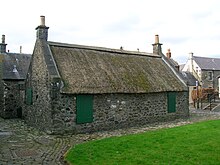
Flax fiber is extracted from the bast or skin of the stem of the flax plant. Flax fiber is soft, lustrous and flexible; bundles of fiber have the appearance of blonde hair, hence the description "flaxen". It is stronger than cotton fiber but less elastic. The best grades are used for linen fabrics such as damasks, lace and sheeting. Coarser grades are used for the manufacturing of twine and rope, and historically for canvas and webbing equipment. Flax fiber is a raw material used in the high-quality paper industry for the use of printed banknotes and rolling paper for cigarettes and tea bags. Flax mills for spinning flaxen yarn were invented by John Kendrew and Thomas Porthouse of Darlington in 1787. New methods of processing flax and the rising price of cotton have led to renewed interest in the use of flax as an industrial fiber.
Production
Cultivation

The soils most suitable for flax, besides the alluvial kind, are deep loams, and containing a large proportion of organic matter. Flax is often found growing just above the waterline in cranberry bogs. Heavy clays are unsuitable, as are soils of a gravelly or dry sandy nature. Farming flax requires few fertilizers or pesticides. Within eight weeks of sowing, the plant will reach 10–15 cm in height and will grow several centimeters per day under its optimal growth conditions, reaching 70–80 cm within fifteen days.
Production by country
| Top ten linseed producers – 2011 | ||||
|---|---|---|---|---|
| Country | Production (metric tons) | Footnote | ||
| 368,300 | ||||
| 350,000 | * | |||
| 230,000 | * | |||
| 147,000 | ||||
| 71,000 | ||||
| 70,890 | ||||
| 65,420 | ||||
| 64,000 | * | |||
| 51,100 | ||||
| 32,170 | ||||
| World | 1,602,047 | A | ||
| No symbol = Official data, * = Unofficial figure, A = Aggregate (may include official, semi-official or estimated data) | ||||
Diseases
Main article: List of flax diseasesHarvesting
- Maturation
Flax is harvested for fiber production after approximately 100 days, or a month after the plant flowers and two weeks after the seed capsules form. The base of the plant will begin to turn yellow. If the plant is still green, the seed will not be useful, and the fiber will be underdeveloped. The fiber degrades once the plant is brown.
Methods

There are two ways to harvest flax, one involving mechanized equipment (combines), and a second method, more manual and targeted towards maximizing the fiber length.
Mechanical
The mature plant is cut with mowing equipment, similar to hay harvesting, and raked into windrows. When dried sufficiently, a combine then harvests the seeds similar to wheat or oat harvesting. The amount of weeds in the straw affects its marketability, and this coupled with market prices determined whether the farmer chose to harvest the flax straw. If the flax was not harvested, it was typically burned, since the straw stalk is quite tough and decomposes slowly (i.e., not in a single season), and still being somewhat in a windrow from the harvesting process, the straw would often clog up tillage and planting equipment. It was common, in the flax growing regions of western Minnesota, to see the harvested flax straw (square) bale stacks start appearing every July, the size of some stacks being estimated at 10-15 yards wide by 50 or more yards long, and as tall as a two-story house.
Manual
The mature plant is pulled up with the roots (not cut), so as to maximize the fiber length. After this, the flax is allowed to dry, the seeds are removed, and is then retted. Dependent upon climatic conditions, characteristics of the sown flax and fields, the flax remains on the ground between two weeks and two months for retting. As a result of alternating rain and the sun, an enzymatic action degrades the pectins which bind fibers to the straw. The farmers turn over the straw during retting to evenly rett the stalks. When the straw is retted and sufficiently dry, it is rolled up. It will then be stored by farmers before scutching to extract fibers.
Flax grown for seed is allowed to mature until the seed capsules are yellow and just starting to split; it is then harvested by combine harvester and dried to extract the seed.
Threshing flax
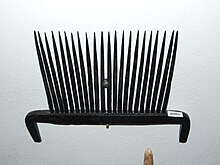

Threshing is the process of removing the seeds from the rest of the plant. As noted above in the Mechanical section, the threshing could be done in the field by a machine, or in another process, a description of which follows:
The process is divided into two parts: the first part is intended for the farmer, or flax-grower, to bring the flax into a fit state for general or common purposes. This is performed by three machines: one for threshing out the seed, one for breaking and separating the straw (stem) from the fiber, and one for further separating the broken straw and matter from the fiber. In some cases the farmers thrash out the seed in their own mill and therefore, in such cases, the first machine will be unnecessary.
The second part of the process is intended for the manufacturer to bring the flax into a state for the very finest purposes, such as lace, cambric, damask, and very fine linen. This second part is performed by the refining machine only.
The threshing process would be conducted as follows:
- Take the flax in small bundles, as it comes from the field or stack, and holding it in the left hand, put the seed end between the threshing machine and the bed or block against which the machine is to strike; then take the handle of the machine in the right hand, and move the machine backward and forward, to strike on the flax, until the seed is all threshed out.
- Take the flax in small handfuls in the left hand, spread it flat between the third and little finger, with the seed end downwards, and the root-end above, as near the hand as possible.
- Put the handful between the beater of the breaking machine, and beat it gently till the three or four inches, which have been under the operation of the machine, appear to be soft.
- Remove the flax a little higher in the hand, so as to let the soft part of the flax rest upon the little finger, and continue to beat it till all is soft, and the wood is separated from the fiber, keeping the left hand close to the block and the flax as flat upon the block as possible.
- The other end of the flax is then to be turned, and the end which has been beaten is to be wrapped round the little finger, the root end flat, and beaten in the machine till the wood is separated, exactly in the same way as the other end was beaten.
Preparation for spinning
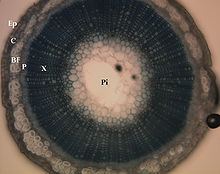
Before the flax fibers can be spun into linen, they must be separated from the rest of the stalk. The first step in this process is called retting. Retting is the process of rotting away the inner stalk, leaving the outer fibers intact. At this point there is still straw, or coarse fibers, remaining. To remove these the flax is "broken," the straw is broken up into small, short bits, while the actual fiber is left unharmed, then "scutched," where the straw is scraped away from the fiber, and then pulled through "hackles," which act like combs to comb the straw out of the fiber.
In Ireland 'hackling' was the term used for the final process in preparing flax for spinning into linen. A hackler, strictly speaking, is a person involved in the process of refining flax, which used to be grown in abundance in County Cavan, Ireland. Prior to the industry becoming mechanised and moving to East Ulster, it was a rural based cottage industry with Cootehill as Ulster's largest market.
The Hackler from Grouse Hall is an Irish song written in the late 1880s by a local man, Peter Smith, from Stravicnabo, Lavey. It has been sung by Christy Moore, Planxty and Damien Dempsey.
In the 1990s a product known as The Hackler, an Irish poitin, was developed by Cooley Distillery. So popular was this song that the promotional literature originally referred incorrectly to a hackler as a maker of poitin. This error was subsequently corrected.
Retting flax
There are several methods of retting flax. It can be retted in a pond, stream, field or tank. When the retting is complete, the bundles of flax feel soft and slimy, and quite a few fibers are standing out from the stalks. When wrapped around a finger the inner woody part springs away from the fibers.
Pond retting is the fastest. It consists of placing the flax in a pool of water which will not evaporate. It generally takes place in a shallow pool which will warm up dramatically in the sun; the process may take from a couple of days to a few weeks. Pond retted flax is traditionally considered of lower quality, possibly because the product can become dirty, and is easily over-retted, damaging the fiber. This form of retting also produces quite an odor.
Stream retting is similar to pool retting, but the flax is submerged in bundles in a stream or river. This generally takes two or three weeks longer than pond retting, but the end product is less likely to be dirty, does not smell as bad and, because the water is cooler, is less likely to be over-retted.
Both pond and stream retting were traditionally used less because they pollute the waters used for the process.
In field retting, the flax is laid out in a large field, and dew is allowed to collect on it. This process normally takes a month or more but is generally considered to provide the highest quality flax fibers, and it produces the least pollution.
Retting can also be done in a plastic trash can or any type of water-tight container of wood, concrete, earthenware or plastic. Metal containers will not work, as an acid is produced when retting, and it would corrode the metal. If the water temperature is kept at 80 °F (27 °C), the retting process under these conditions takes 4 or 5 days. If the water is any colder, it takes longer. Scum will collect at the top, and an odor is given off the same as in pond retting. 'Enzymatic' retting of flax has been researched as a retting technique to engineer fibers with specific properties.
Dressing the flax
Dressing the flax is the process of removing the straw from the fibers. Dressing consists of three steps: breaking, scutching, and heckling. The breaking breaks up the straw. Some of the straw is scraped from the fibers in the scutching process, and finally the fiber is pulled through heckles to remove the last bits of straw.
The dressing is done as follows:
- Breaking: The process of breaking breaks up the straw into short segments. To do it, take the bundles of flax and untie them. Next, in small handfuls, put it between the beater of the breaking machine (a set of wooden blades that mesh together when the upper jaw is lowered, which look like a paper cutter but instead of having a big knife it has a blunt arm), and beat it till the three or four inches that have been beaten appear to be soft. Move the flax a little higher and continue to beat it till all is soft, and the wood is separated from the fiber. When half of the flax is broken, hold the beaten end and beat the rest in the same way as the other end was beaten, till the wood is separated.
- Scutching: In order to remove some of the straw from the fiber, it helps to swing a wooden scutching knife down the fibers while they hang vertically, thus scraping the edge of the knife along the fibers and pull away pieces of the stalk. Some of the fiber will also be scutched away, this cannot be helped and is a normal part of the process.
- Heckling: In this process the fiber is pulled through various different sized heckling combs or heckles. A heckle is a bed of "nails"—sharp, long-tapered, tempered, polished steel pins driven into wooden blocks at regular spacing. A good progression is from 4 pins per square inch, to 12, to 25 to 48 to 80. The first three will remove the straw, and the last two will split and polish the fibers. Some of the finer stuff that comes off in the last hackles is called "tow" and can be carded like wool and spun. It will produce a coarser yarn than the fibers pulled through the heckles because it will still have some straw in it.
Genetically modified flax contamination

In September 2009 it was reported that Canadian flax exports had been contaminated by a de-registered genetically modified (GM) variety, known as Triffid. Triffid had food and feed safety approval in both Canada and the U.S. However, Canadian growers and the Flax Council of Canada had raised concerns about the marketability of this variety in Europe. The variety was subsequently de-registered in 2001 and never grown commercially in Canada or the U.S. All stores of the seed were purportedly crushed or destroyed. Despite these precautions flax exports were found to contain traces of this transgenic flax variety which resulted in problems for Canada's flax growers and the industry at large, who export 70% of their product to Europe. The EU currently has a zero tolerance policy regarding unapproved GMOs. Canadian flaxseed cultivars were reconstituted with triffid free seed which were used in planting the 2014 crop. Laboratories are certified to test for the presence of "Triffid" seed at one part in 10,000
Symbolic images
Flax is the emblem of Northern Ireland and used by the Northern Ireland Assembly. In a coronet, it appeared on the reverse of the British one pound coin to represent Northern Ireland on coins minted in 1986, 1991 and 2014. Flax also represents Northern Ireland on the badge of the Supreme Court of the United Kingdom and on various logos associated with it.
Common flax is the national flower of Belarus.
In early tellings of the Sleeping Beauty tale, such as "Sun, Moon, and Talia" by Giambattista Basile, the princess pricks her finger not on a spindle but on a sliver of flax, which is later sucked out by her children conceived as she sleeps.
See also
References
- "The Plant List: A Working List of All Plant Species". Retrieved 2 October 2014.
- "USDA GRIN Taxonomy". Retrieved 2 October 2014.
- Allaby, R.; Peterson, G.; Merriwether, D.; Fu, Y.-B. (2005). "Evidence of the domestication history of flax (Linum usitatissimum L.) from genetic diversity of the sad2 locus". Theoretical and Applied Genetics. 112 (1): 58–65. doi:10.1007/s00122-005-0103-3.
{{cite journal}}: CS1 maint: multiple names: authors list (link) - Quanru Liu and Lihua Zhou. "Linum". Flora of China. Vol. 11. Retrieved 2 October 2014.
- "These Vintage Threads Are 30,000 Years Old". NPR. Retrieved 2010-11-13.
- Balter M. (2009). Clothes make the (Hu) Man. Science, 325(5946):1329. doi:10.1126/science.325_1329a PMID 19745126
- Kvavadze E, Bar-Yosef O, Belfer-Cohen A, Boaretto E, Jakeli N, Matskevich Z, Meshveliani T. (2009).30,000-Year-Old Wild Flax Fibers. Science, 325(5946):1359. doi:10.1126/science.1175404 PMID 19745144 Supporting Online Material
- ^ Fu, Y.-B. (2011). "Genetic evidence for early flax domestication with capsular dehiscence". Genetic Resources and Crop Evolution. 58 (8): 1119–1128. doi:10.1007/s10722-010-9650-9.
- Barber E. (1991) "Prehistoric Textiles: The Development of Cloth in the Neolithic and Bronze Ages with Special Reference to the Aegean". Princeton University Press, p.12
- Cullis C. (2007) "Oilseeds" Springer, p. 275
- Sekhri S. (2011) "Textbook of Fabric Science: Fundamentals to Finishing". PHI Learning Private Limited, New Delhi, p. 76
- Wisseman S. (2013) "Ancient Technologies and Archaeological Materials". Routledge, p. 124
- Buchanan R. (2012) "A Weaver's Garden: Growing Plants for Natural Dyes and Fibers". Courier Dover Publications, p. 22
- ^ Wisseman S., p.125
- Cullis C. p.275
- (2003) "The Oxford Encyclopedia of Economic History, Volume 1" oxford university press, p.303
- McHughen A. (1990) "Flax (Linum usitatissimum L.): In Vitro Studies", Biotechnology in Agriculture and Forestry Volume 10, pp 502-514
- Grant, Amanda (2007-03-06). "Superfoods". The Guardian. London.
- http://www.webexhibits.org/pigments/intro/renaissance.html
- "Flax nutrition profile". Retrieved 2008-05-08.
- ^ Mayo Clinic (2006-05-01). "Drugs and Supplements: Flaxseed and flaxseed oil (Linum usitatissimum)". Retrieved 2007-07-02.
- Chopra (1933) "Indigenous Drugs Of India", Academic Publishers, p.677
- Alpers, Linda; Sawyer-Morse, Mary K. (August 1996). "Eating Quality of Banana Nut Muffins and Oatmeal Cookies Made With Ground Flaxseed". Journal of the American Dietetic Association. 96 (8): 794–796. doi:10.1016/S0002-8223(96)00219-2. PMID 8683012.
- "Heat Treatment and Thirty-Day Storage Period Do Not Affect the Stability of Omega-3 Fatty Acid in Brown Flaxseed (Linum Usitatissimum) Whole Flour". FNS. June 2011.
- Malcolmson, L.J. (April 2006). "Storage stability of milled flaxseed". Retrieved 2008-04-24.
- Chen, Z-Y. "Oxidative stability of flaxseed lipids during baking". JAOCS 1994; 71(6):629-632.
- "Phenolic glucosides in bread containing flaxseed." C. Strandås, A. Kamal-Eldin, R. Andersson and P. Åman, Food Chemistry, Volume 110, Issue 4, 15 October 2008, Pages 997–999, doi:10.1016/j.foodchem.2008.02.088
- Vogl S, Picker P, Mihaly-Bison J, Fakhrudin N, Atanasov AG, Heiss EH, Wawrosch C, Reznicek G, Dirsch VM, Saukel J, Kopp B. "Ethnopharmacological in vitro studies on Austria's folk medicine - An unexplored lore in vitro anti-inflammatory activities of 71 Austrian traditional herbal drugs." J Ethnopharmacol. 2013 June 13. doi:pii: S0378-8741(13)00410-8. 10.1016/j.jep.2013.06.007. PubMed PMID 23770053. http://www.ncbi.nlm.nih.gov/pubmed/23770053
- United States Food and Drug Administration (2024). "Daily Value on the Nutrition and Supplement Facts Labels". FDA. Archived from the original on 2024-03-27. Retrieved 2024-03-28.
- National Academies of Sciences, Engineering, and Medicine; Health and Medicine Division; Food and Nutrition Board; Committee to Review the Dietary Reference Intakes for Sodium and Potassium (2019). "Chapter 4: Potassium: Dietary Reference Intakes for Adequacy". In Oria, Maria; Harrison, Meghan; Stallings, Virginia A. (eds.). Dietary Reference Intakes for Sodium and Potassium. The National Academies Collection: Reports funded by National Institutes of Health. Washington, DC: National Academies Press (US). pp. 120–121. doi:10.17226/25353. ISBN 978-0-309-48834-1. PMID 30844154. Retrieved 2024-12-05.
- "Meta-analysis of the effects of flaxseed interventions on blood lipids," Pan A, Yu D, Demark-Wahnefried W, Franco OH, Lin X, Am J Clin Nutr. 2009 Aug; 90(2): 288–97.
- Iowa State NWRC study finds flaxseed lowers high cholesterol in men
- Chen J, Wang L, Thompson LU (2006). "Flaxseed and its components reduce metastasis after surgical excision of solid human breast tumor in nude mice". Cancer Lett. 234 (2): 168–75. doi:10.1016/j.canlet.2005.03.056. PMID 15913884.
{{cite journal}}: CS1 maint: multiple names: authors list (link) - Thompson LU, Chen JM, Li T, Strasser-Weippl K, Goss PE (2005). "Dietary flaxseed alters tumor biological markers in postmenopausal breast cancer". Clin. Cancer Res. 11 (10): 3828–35. doi:10.1158/1078-0432.CCR-04-2326. PMID 15897583.
{{cite journal}}: CS1 maint: multiple names: authors list (link) - ^ "Flaxseed Stunts The Growth Of Prostate Tumors". ScienceDaily. 2007-06-04. Retrieved 2007-11-23.
- Demark-Wahnefried, Wendy; Polascik, Thomas J.; George, Stephen L.; Switzer, Boyd R.; Madden, John F.; Ruffin IV, Mack T.; Snyder, Denise C.; Owzar, Kouros; Hars, Vera; David M., Albala; Walther, Philip J.; Robertson, Cary N.; Moul, Judd W.; Dunn, Barbara K.; Brenner, Dean; Minasian, Lori; Philip, Stella; Vollmer, Robin T. "Flaxseed Supplementation (Not Dietary Fat Restriction) Reduces Prostate Cancer Proliferation Rates in Men Presurgery". http://cebp.aacrjournals.org/. Cancer Epidemiology, Biomarkers & Prevention. Retrieved 30 December 2014.
{{cite web}}: External link in|website= - Am J Clin Nutr (March 25, 2009). doi:10.3945/ajcn.2009.26736Ev1
- Dahl, WJ; Lockert, EA; Cammer, AL; Whiting, SJ (December 2005). "Effects of Flax Fiber on Laxation and Glycemic Response in Healthy Volunteers". Journal of Medicinal Food. 8 (4): 508–511. doi:10.1089/jmf.2005.8.508. PMID 16379563. Retrieved 2007-05-14.
- ^ "Flaxseed and Flaxseed Oil". National Center for Complementary and Alternative Medicine. Retrieved 2008-01-03.
- Caligiuri SP et al. Exp Gerontol. 2014 Apr 18. Elevated levels of pro-inflammatory oxylipins in older subjects are normalized by flaxseed consumption.
- SP Caligiuri et al. Hypertension. 2014 Jul;64(1):53-9. Flaxseed consumption reduces blood pressure in patients with hypertension by altering circulating oxylipins via an α-linolenic acid-induced inhibition of soluble epoxide hydrolase.
- Webmd.com
- http://www.fda.gov/ucm/groups/fdagov-public/@fdagov-foods-gen/documents/document/ucm264266.pdf
- Banea-Mayambu JP, Tylleskar T, Gitebo N, Matadi N, Gebre-Medhin M, Rosling H. (1997). Geographical and seasonal association between linamarin and cyanide exposure from cassava and the upper motor neurone disease konzo in former Zaire. Trop Med Int Health 2(12):1143-51. PMID 9438470
- Wardey, A. J. (1967). The Linen Trade: Ancient and Modern. Routledge. p. 752. ISBN 0-7146-1114-X.
- Foulk Akin Dodd (2008). "Pectinolytic enzymes and retting," BioResources 3(1), 155-169
- Foulk Akin Dodd (2001) "Processing techniques for improving enzyme-retting of flax," Industrial Crops and Products 13 (2001) 239–248
- "Canada moves to revive flax exports after GMO flap". Reuters. 2010-01-08. Retrieved 2012-11-11.
- http://www.producer.com/2013/01/flax-growers-try-to-flush-triffid-from-system%E2%80%A9/
- http://www.grainscanada.gc.ca/gmflax-lingm/stpf-peevl-en.pdf
Sources
- Carr, Sir Cecil Thomas (1970). Select Charters of Trading Companies, A.D. 1530-1707. Ayer Publishing. p. 87. ISBN 978-0-8337-0479-5. Retrieved 2012-09-07.
{{cite book}}: Invalid|ref=harv(help) - Fortescue, Sir John William (1860). Calendar of State Papers: 9- America and West Indies, 1574. Longman. Retrieved 2012-09-07.
{{cite book}}: Invalid|ref=harv(help)
External links
- North Dakota State University picture comparing flaxseed oil fatty acid content with other oils.
- The produce arising from one acre of ground with flaxseed consider'd (Gentleman's magazine, 1742)
| Fibers | |||||||||
|---|---|---|---|---|---|---|---|---|---|
| Natural |
| ||||||||
| Synthetic |
| ||||||||


